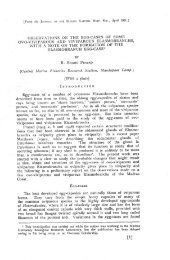PDF - Eprints@CMFRI
PDF - Eprints@CMFRI
PDF - Eprints@CMFRI
You also want an ePaper? Increase the reach of your titles
YUMPU automatically turns print PDFs into web optimized ePapers that Google loves.
161<br />
2. Corallum mainly flabelloid with long valleys, 15 to 25 mm wide and deep. Septa highly exserr, edges<br />
entire. Columella absent. Series separated into independent flabellate branches ...... . . .. Plerogyra<br />
3. Corallu m mainly meandroid , details as in Plerogyra , but series closely united by walls . ... Physogyra<br />
4. Corallum explanate, pedunculate, meandroid. Valleys 6 to 10 mm wide. Collines thin with a middlegroove<br />
.. . ......... .................... . ........ . ...................... . Gyrosmilia<br />
Genus Euphyllia DANA, 1846<br />
Type s pecie s: Caryophylliaglabrescens CHAM ISSO & EVSENHARDT, 1821.<br />
G e n e ric c h a r act e r s : Phaceloid, branches free throughout the length , diverging. Corallites<br />
monocentric (20 to 30 mm in diameter) or forming valleys, very deep. Septa very thin, slightly exsert,<br />
edges entire, sides smooth. Columella absent.<br />
With regard to the list of synonyms of the several species a far-reaching agreement exists between the<br />
different authors as VAUGHAN (19 18), MATTHAI (1928), CHEVALIER (1971) and VERON & PICHON<br />
(1980). The only greater difference is the position of E. turgida. MATTHAI considers it as a particular<br />
species, VAUGHAN and CHEVALIER put it to E. fimbriata , and VERON & PICHON to E. glabrescens.<br />
The present authors agree with this latter opinion, because E. glabrescens and E. turgida are mostly<br />
phaceloid with mono-, di- or tristomodaeal corallites. On the other hand, E. fimbriata is mainly phacelloflabellate<br />
with more or less long meandroid valleys. Moreover another phenomenon justifies this decision,<br />
too.<br />
VERON & PICHON (1980) subdivide the genus Euphyllia in two subgenera: 1. Euphyllia with E.(E.)<br />
glabrescens and E. (E.)cristata, and 2. Fimbriaphyllia with the new species E. (F.)divisa and E. (F.)ancora<br />
instead of E. fimbriata . They make the interesting statement, that these two new species can be distinguished<br />
only by the tentacles of their polyps and that, in this regard, they are unique in scleracrinian<br />
taxonomy. E.(F.)divisa has long tentacles, thick at their base and dividing and branching with light caps.<br />
The polyps of E.(F.)ancora have long tentacles with pale caps which are curved or crescentic in shape,<br />
wheteas the tentacles of E.(E.)glabrescens (including E. turgida) and E. (E.)cristata are long and tubular<br />
with white ends.<br />
Caryopbyllw<br />
Eupbyllia<br />
Euphyllia glabrescens (CHAMISSO and EVSENHARDT), 1821<br />
glabresuns<br />
glabrescens<br />
lurgida<br />
(Plate 37, Figs, 1- 3)<br />
1821 , CHAMISSO & EYSENHARDT. 269; pI. H / IA,B (Type locality : Raddak lsI.. Australia),<br />
1904. GARDINER, 759.<br />
1918, VAUGHAI'Ir,j , 82 j fig. liP!. 26/2, 3. 3a..<br />
1928, ft\A TTHAI. 174; pis. 3117-21; 42/ S; 4414 ; 62/9 (synonymy).<br />
1952, CROSSLAND. 104; pI. 2/6.<br />
1971, CHEVALIER. 26 ; pi s. 1/ 3; 3/ 3.<br />
1974. SCHEER & PILLA!. 61.<br />
1976. PILLAI & SCHEER. 69.<br />
1980, VERON & PICHON, 342 ; figs. 606-610, 822 (lop right), 823.<br />
1911 , GRAVIER, H i P!. 2/5- 8.<br />
1846. DANA, 166; pI. 6/ 4.<br />
1904, GARDINER, 7.59.<br />
1928, MATTHAI, 117; pis. 40/2; 5212; 59/2 (synonymy).<br />
1976. PI LLAI & SCHEER. 70.<br />
One specimen in the present collection was labelled by the late Peter WETTSTEIN as E. turgida. The<br />
specimen was collected by N. GUNDERMAN at a depth of 60 m. It is represented by four corallites, two<br />
of them s e~~rate and the others a branch wah two corallites. The general appearance is similar to the one<br />
from MauritIUS , figured by MATTHAI (I928 , pI. 52, fig. 2) under E. turgida. All the corallites are monostomodaeal<br />
and range from 19 to 30 mm in greater diameter. The wall is very thin. There are 7 to 10 septa<br />
per cm length of the wall, of which 4 ro 5 are larger than the others. Major septa about 1.7 mm exsert,<br />
not swollen at the wall. At the bottom of the calyx they turn left or right and extend to the centre of the
















